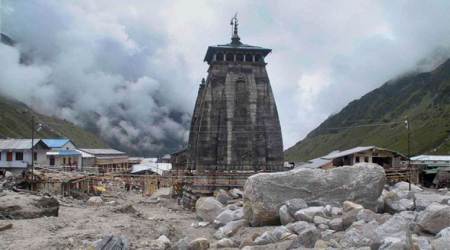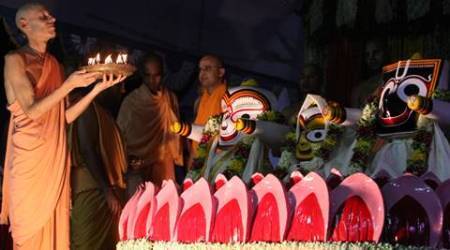When ice was a luxury item and shipped to Calcutta from the US
Some three centuries before the British mesmerised Calcutta with ice, Mughal emperor Babur had transported ice on elephants and horseback from Kashmir to Delhi. The British tried to emulate the practice but soon gave up. Then ‘American ice’ happened.
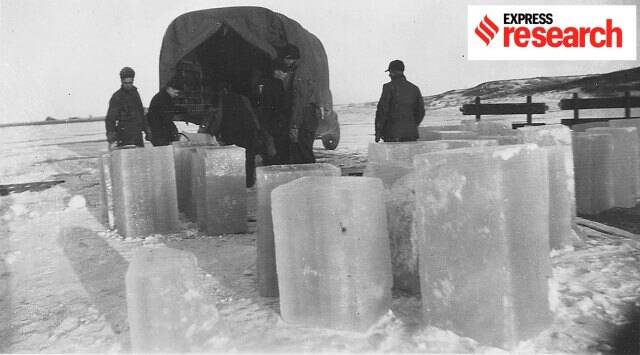 The American-origin ice that was shipped to Calcutta meant that drinks could be enjoyed the way the colonialists were accustomed to. (Photo credit: U.S. National Archives and Records Administration/Wikimedia Commons)
The American-origin ice that was shipped to Calcutta meant that drinks could be enjoyed the way the colonialists were accustomed to. (Photo credit: U.S. National Archives and Records Administration/Wikimedia Commons) An entry in the first edition of the Oriental Herald and Colonial Intelligencer by Parbury, published in 1838, gives some fascinating insight into the early years of Calcutta and its relationship with ice, a coveted product in colonial India. There is a good amount of literature on how colonial powers in the subcontinent coped with what they considered to be oppressive temperatures. While some ways included traipsing up to hill stations to escape the heat, by the 19th century, there was another novel addition: ice.
In the subcontinent, the domestic use of ice wasn’t completely unknown. Some three centuries before the British mesmerised the city of Calcutta with ice, Babur, the first Mughal emperor, used his extensive resources to transport ice on elephants and horseback from Kashmir to the capital in Delhi.
There is some archival documentation to indicate that the British did attempt to emulate the Mughals’ practice of transporting ice from Kashmir, but the expenses involved resulted in the East India Company officials dropping those plans and, instead, focusing on American ice.
There was more to the British East India Company’s lack of ability in bringing ice from Kashmir and the wider Himalayas to Calcutta, says Tathagata Neogi, historian and co-founder of Immersive Trails. “Bengal did not necessarily have that access because the high Himalayas were under the Coochbehar kingdom, Nepal, Bhutan and Sikkim. So the Dutch started producing something in Bengal called ‘Hooghly ice’. This was basically a watery slush made in very deep pits in Chinsurah and Hooghly. This slush was of course not drinkable by itself, and was imported into other European colonies to cool drinks by putting the slush in a large cup, and placing smaller cups containing drinks inside the slush,” says Neogi.
The American-origin ice that was shipped to Calcutta meant that drinks could be enjoyed the way the colonialists were accustomed to.
When ice first arrived on Calcutta’s docks on a ship called ‘The Clipper Tuscany’ in September 1833 from the American city of Boston, the colonial inhabitants of the city were overjoyed. The packed ice had survived around a four-month long voyage across the many seas and the 100 tonnes of ice that eventually reached the colonial residents of the city was such an enormous occurrence that the first British governor-general of Bengal, William Bentinck, lauded the ship’s crew, especially the man in charge of the precious cargo, William C. Rogers.
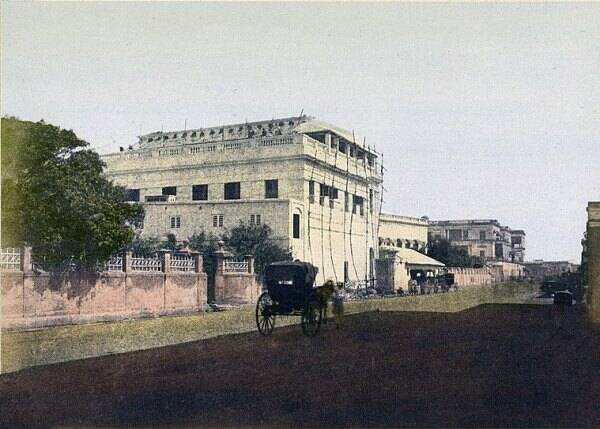 A hand-coloured print of Ice House, Calcutta, from the Fiebig Collection: Views of Calcutta and Surrounding Districts, taken by Frederick Fiebig in 1851. Ice Houses were built in Calcutta, Bombay and Madras by Fredric Tudor, a merchant from Boston, who first brought ice to India in 1833 on a ship called ‘The Clipper Tuscany’. (Photo credit: The British Library)
A hand-coloured print of Ice House, Calcutta, from the Fiebig Collection: Views of Calcutta and Surrounding Districts, taken by Frederick Fiebig in 1851. Ice Houses were built in Calcutta, Bombay and Madras by Fredric Tudor, a merchant from Boston, who first brought ice to India in 1833 on a ship called ‘The Clipper Tuscany’. (Photo credit: The British Library)
The Oriental Herald and Colonial Intelligencer states that the first ice house in Bengal cost Rs. 10,500, an astronomical sum of money at that time, and was used to store “American ice”. But it appears that the ice house did not function as it was expected to, and “a strong appeal had been put forth to the public for subscriptions to erect an additional one. This appeal has been somewhat usually, particularly addressed to the ladies, who have answered it by subscribing Rs. 1452; the gentlemen have come forward with Rs. 6435, making a total of Rs. 7959; but the lists are still open,” the entry says.
While a luxury commodity in 19th century Bengal, the ice wasn’t completely inaccessible at four annas a pound, but was consumed only by the British and other Europeans in the city.
It is not clear when the Tudor Ice Company was established by Frederic Tudor, the American merchant who built a significant part of his fortune on the trade of ice, but for close to two decades, he dominated this trade. “The Tudor Ice Company founded by Frederick Tudor in Boston was the only player importing ice to India and Calcutta all the way from the US in their specially made ships. Locally in Calcutta, and other coastal colonial cities, ice houses were erected,” says Neogi.
In his paper ‘The American Ice Harvests; A Historical Study in Technology, 1800–1918’, author Richard O. Cummings states that the ice that Tudor shipped across the seas to Calcutta, were harvested from the frozen rivers, ponds and streams of Massachusetts during New England’s cold winters.
The Journal of the Asiatic Society provides some insight into how the ice was harvested by Tudor and his fellow ice traders. The process of harvesting ice involved cutting blocks of ice frozen on water bodies. In the early years of the trade, it was done by men using pickaxes, chisels and other similar tools. But it was soon replaced by a horse-drawn contraption.
One of the biggest challenges involved perfecting the art of storing ice, which in the early years of the trade, had a tendency to melt in the absence of proper storage facilities in America itself, even before it was loaded onto the ships. By 1810, Tudor had figured a way of storing ice in special ice depots, with the first depot being built in 1810 in Havana, despite an American trade embargo on Cuba.
The Americans remained the only player in ice imports into the Indian subcontinent, but appointed local agents in the cities where they operated for logistical reasons. In Calcutta, the family of Akrur Dutta in Bowbazar was their Calcutta agent, says Neogi.
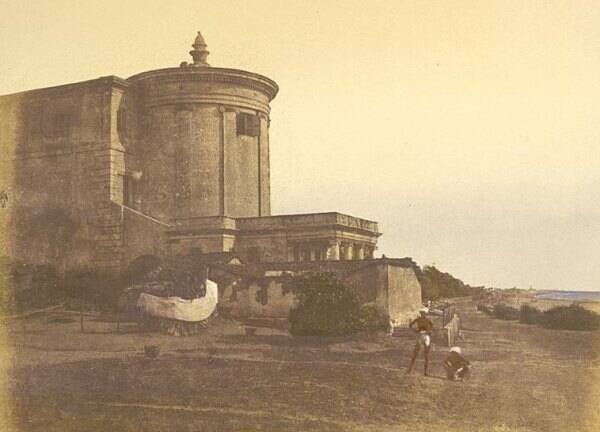 Photograph of the ice house at Madras (Chennai), Tamil Nadu, taken by Frederick Fiebig in c.1851. The photograph is one of a series of hand-coloured salt prints. The ice house stood beside the road on the foreshore next to Marina Beach. It is a handsome circular building with ionic pilasters and a pineapple finial. The ice house was erected in 1842 to store large blocks of ice which were imported from America by the Tudor Ice Co., formed in 1840. Following the construction of local ice factories it was later converted into a home for Brahmin widows and is now a hostel for the Lady Willingdon Training College, known as Vivekananda House. (Photo credit: The British Library)
Photograph of the ice house at Madras (Chennai), Tamil Nadu, taken by Frederick Fiebig in c.1851. The photograph is one of a series of hand-coloured salt prints. The ice house stood beside the road on the foreshore next to Marina Beach. It is a handsome circular building with ionic pilasters and a pineapple finial. The ice house was erected in 1842 to store large blocks of ice which were imported from America by the Tudor Ice Co., formed in 1840. Following the construction of local ice factories it was later converted into a home for Brahmin widows and is now a hostel for the Lady Willingdon Training College, known as Vivekananda House. (Photo credit: The British Library)
Dutta was originally a sloop merchant based in Bengal, selling the inferior domestic slush produced in Hooghly, With the arrival of American ice, it was perhaps only logical that Dutta was in an advantageous position to trade in the superior version of the product that he was originally selling. The business made Dutta and other merchants like him very wealthy. Ice houses were constructed not just in Calcutta but also in other parts of the subcontinent where the British East India Company operated from, like Madras and Bombay.
After cotton, ice had by 1847 become the second-most important trade commodity between America and the Indian subcontinent. In addition to its consumption by the privileged colonial residents, the imported ice was also used for storage. “When the first shipment of ice arrived it was sent to keep a large shipment of American apples fresh. So here it was used for similar reasons — most important being cooling drinks in parties. Having ice at home was a matter of privilege and a show of one’s wealth. So often in September-October, the ice import season, a tonne of iced champagne dinners were organised by the Calcutta elite. Ice was too expensive for common people to access, and it was such a rarity that one needed a doctor’s prescription to get access to some ice, if you did not know the right people,” says Neogi.
“The East India Company allowed tax free import of Ice for the Tudor Ice Company, but this privilege was taken away in 1853 in an executive decision by Governor General Lord Dalhousie,” says Neogi.
Among the Indians, their relationship with ice was slightly complex. “Initially, there were mixed feelings. The first Indians in Bengal to encounter ice were the port labourers. They were sceptical about (this thing) that gave you a shiver when touched but also had smoke coming out of it. So they thought ice was a cursed item, and demanded more money to offload it from ships that brought them. In general the Indian elites, who could afford them, saw it as a curiosity and a thing of privilege,” says Neogi.
In her 2009 paper ‘Culture of Food in Colonial Bengal’, author Utsa Ray writes that in colonial Bengal, “whatever was new was considered a caste taboo. “Mahendranath Datta, brother of the famous religious preacher Vivekananda, wrote for instance: My youngest uncle used to buy ice and brought it home covered with a blanket. This ice needed to be preserved with sawdust. That was a strange thing. Orthodox Hindus never consumed it. In our house, widows also abstained from it. We tried it out but in a sneaking manner. Maybe that’s why we did not lose our caste so soon.”
A little less than two decades later, the American ice trade suffered a bigger blow. The colonial powers had discovered new, modern methods of ice-making, phasing out the need for American ice. So redundant had American ice become that the British established the Calcutta ice factory in 1878 and razed the city’s old ice house in 1882. The fate of the ice houses in Madras and Bombay followed a similar trajectory and by the late 1880s, these establishments were also pulled down.


